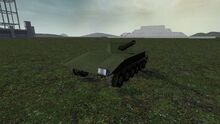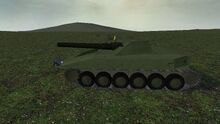The IFV-20 series is the primary IFV produced by CDF.
| IFV-20 | |
|---|---|
| The IFV-20A2. | |
| The IFV-20A2. | |
Design
| |
| Designer | Redreaper |
| Role | infantry fighting vehicle |
Specifications
| |
| Weight | 20 tons |
| Armor | 250-350+mm / 100+mm / 45mm. Spaced armor and frontal powerpack. |
| Primary Armament | 75mmSC / 30mmAC / 75mmSC |
| Secondary Armament | varies, machine guns |
| Powerplant | 2x V8 gasoline engines, 606hp, 2x V6 multifuel engines, 570hp. Fuel injection. |
| Top Speed | 35+mph |
Strengths[]
- Very survivable
- Amphibious
- Very fast & mobile
- Dangerous gun
- Low weight
Weaknesses[]
- Low damage potential
- Only carries 2 passengers
- Low ammo/fuel capacity
- Thin compared to regular tanks
Design[]
By early 2015, CDF had been producing successfully 10t APCs for quite some time. These were limited in mobility, prone to fire, and unprotected against heavier foes. At the same time, there existed a significant problem of transporting infantry in a high-threat environment, and of these APCs being useless against hard targets.
Development began in late 2014 of a new kind of infantry fighting vehicle. It would support tanks, defend against all infantry weapons, withstand aircraft and tank fire, and have to be mobile in all ways. The requirements emphasized survival and fighting capability of the crew at any cost, blending the "support tank" and "APC" roles.

IFV-20
The resulting design was a vehicle totally unlike its predecessors. The front half of the hull was taken up by a massive powerpack. The sides were filled with ammunition and fuel tanks with firewalls. The hull protected against up to 50mm automatic cannon or almost all forms of antitank missile to the sides, with protection from strafing guns up to 30mm; with its frontal powerpack it could survive 100 and 120mm gun impacts or any known antitank missile. The small, sloped turret was far less armored but seen as sacrificial; if the gun were destroyed the crew was still protected. A full 50% of the internal volume could be penetrated without endangering the passengers, with prioritized ammunition expenditure increasing safety; the two passengers could fire stabilized machine-guns while the vehicle moved, while its soft suspension improved accuracy and comfort. It could go where most tanks could not, faster, and could swim. The 75mm gun fired either HEAT or HE ammo able to penetrate 8 inches of armor, and could fire accurately at up to 300m at speeds up to 20mph on most terrain. It only carried ammo for 1-2 minutes of sustained fire, more than enough given the vehicle's role.
Experience and Evolution[]
The success of the IFV-20 led to great use. It was decided to modernize the design based off experience. The 75mm was felt to be ineffectual against the common heavyweight armor, and the engines fragile.
The modernized IFV-20A1 would see the 75mm replaced with a 30mm automatic cannon for use against helicopters and dug-in troops. It carried an antitank missile on the side of the turret in a one-shot pod. Its engines were also replaced with multifuels, its fuel tanks swapped out for diesel as part of a wider petrol-diesel shift, and its firewall thickened. Less successful than anticipated, it fell into the trap of the APCs it replaced--unable to support tanks. The antitank missile was found to be unreliable and ineffectual; however, the powerplant was a total success.

The modern CDF IFV-20A2
After the IFV-20A1's lackluster performance, the IFV-20A2 was quickly developed. Switching back to the 75mm, new ammunition trades range for killing power. However, it now fits the TOW of the IFV-20A1 as well, and smoke grenades to provide cover for infantry. The vehicle quickly went into common use; despite minor production issues, the IFV-20A2 has been quite successful in its intended role. Despite almost a year of active service, almost no passengers have died while under armor. It is expected to continue to see service for the foreseeable future.